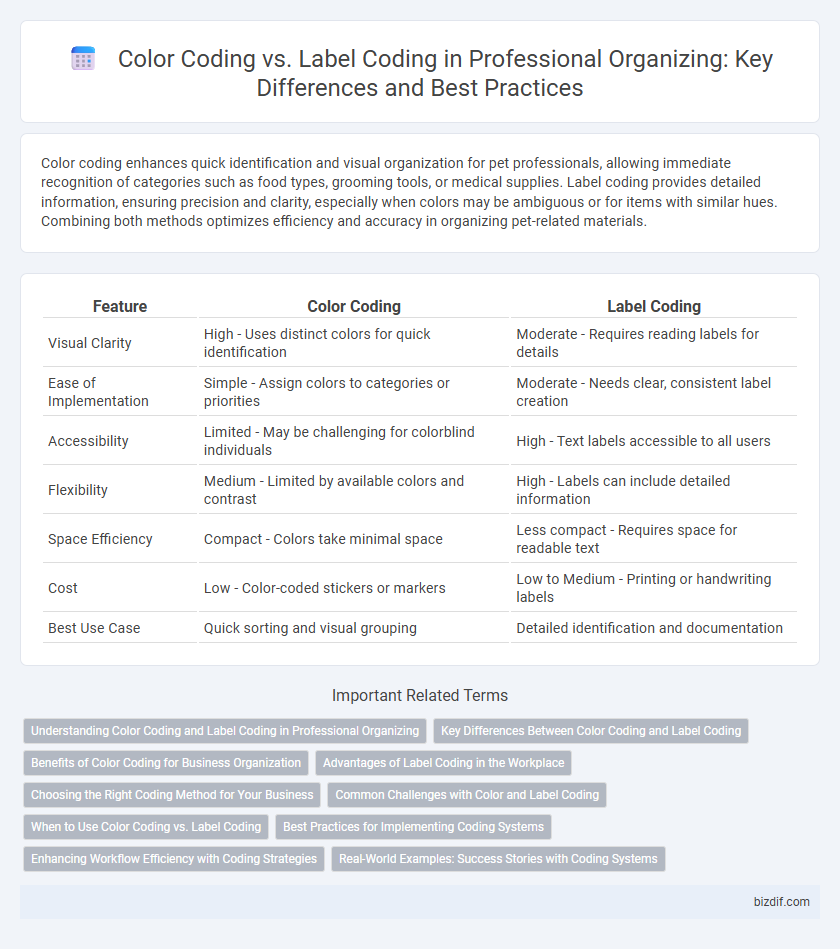Color coding enhances quick identification and visual organization for pet professionals, allowing immediate recognition of categories such as food types, grooming tools, or medical supplies. Label coding provides detailed information, ensuring precision and clarity, especially when colors may be ambiguous or for items with similar hues. Combining both methods optimizes efficiency and accuracy in organizing pet-related materials.
Table of Comparison
| Feature | Color Coding | Label Coding |
|---|---|---|
| Visual Clarity | High - Uses distinct colors for quick identification | Moderate - Requires reading labels for details |
| Ease of Implementation | Simple - Assign colors to categories or priorities | Moderate - Needs clear, consistent label creation |
| Accessibility | Limited - May be challenging for colorblind individuals | High - Text labels accessible to all users |
| Flexibility | Medium - Limited by available colors and contrast | High - Labels can include detailed information |
| Space Efficiency | Compact - Colors take minimal space | Less compact - Requires space for readable text |
| Cost | Low - Color-coded stickers or markers | Low to Medium - Printing or handwriting labels |
| Best Use Case | Quick sorting and visual grouping | Detailed identification and documentation |
Understanding Color Coding and Label Coding in Professional Organizing
Color coding in professional organizing enhances visual recognition by assigning specific colors to categories, improving quick identification and streamlining workflow. Label coding complements this process by providing clear, descriptive tags that specify contents or instructions, reducing ambiguity and ensuring precise organization. Integrating both methods optimizes efficiency, combining intuitive color cues with detailed label information for superior systematization.
Key Differences Between Color Coding and Label Coding
Color coding uses visual cues by assigning specific colors to categories, enhancing quick recognition and spatial organization, while label coding relies on text-based tags for detailed identification and clarity. Color coding excels in environments where immediate visual sorting is critical, but label coding provides precise information, reducing ambiguity in complex systems. Both methods improve efficiency, yet color coding prioritizes visual speed whereas label coding emphasizes descriptive accuracy.
Benefits of Color Coding for Business Organization
Color coding enhances business organization by enabling instant visual recognition, which speeds up workflow and reduces errors in document handling or inventory management. It simplifies categorization across departments, improves communication efficiency, and supports quick decision-making by highlighting priority levels or project status. Businesses using color coding often experience increased productivity and a more streamlined, intuitive organizational system compared to traditional label-only methods.
Advantages of Label Coding in the Workplace
Label coding in the workplace enhances clarity by providing explicit descriptions that reduce misinterpretation and improve task efficiency. Unlike color coding, labels accommodate colorblind individuals and complex information, ensuring accessibility and inclusivity. This method supports seamless communication and organization, optimizing workflow and minimizing errors.
Choosing the Right Coding Method for Your Business
Choosing the right coding method for your business depends on the nature of your inventory and workflow efficiency; color coding offers quick visual identification ideal for high-traffic environments, while label coding provides detailed, customizable information essential for complex product tracking. Combining both methods enhances accuracy and speed by leveraging color for immediate recognition and labels for specific data, optimizing organization and retrieval processes. Assessing your business needs, inventory complexity, and employee preferences ensures the selected coding system maximizes productivity and reduces errors.
Common Challenges with Color and Label Coding
Color coding often faces challenges such as color blindness, which affects approximately 8% of men and 0.5% of women worldwide, making it difficult for some individuals to distinguish colors accurately. Label coding can become problematic when labels are not clear, legible, or consistently applied, leading to confusion and misplacement of items. Both methods require regular maintenance to ensure accuracy and effectiveness in professional organizing systems.
When to Use Color Coding vs. Label Coding
Color coding is ideal for quickly identifying categories or priorities at a glance, making it perfect for environments where speed and visual cues are essential, such as office files or inventory systems. Label coding provides detailed information and specificity, best suited for complex items or where exact descriptions are necessary, like archival storage or detailed project components. Use color coding for broad organization and label coding for clarity and precision when handling diverse or detailed content.
Best Practices for Implementing Coding Systems
Color coding enhances visual recognition and speeds up retrieval by assigning specific hues to categories, making it ideal for quick identification in professional organizing systems. Label coding provides detailed textual information, ensuring clarity and reducing ambiguity, especially in diverse or complex storage environments. Combining color coding with clear, legible labels optimizes organization efficiency and minimizes errors during sorting and locating items.
Enhancing Workflow Efficiency with Coding Strategies
Color coding streamlines workflow efficiency by enabling quick visual identification of categories, reducing the time spent searching for items. Label coding complements this approach by providing precise, text-based information that minimizes errors and enhances clarity in complex organizing systems. Combining both strategies optimizes task management and accelerates retrieval processes in professional environments.
Real-World Examples: Success Stories with Coding Systems
Color coding enhances visual organization in professional settings by allowing quick identification of categories, as seen in offices where files are sorted by colored folders for departments like finance, marketing, and HR. Label coding excels in detailed environments such as warehouses, where precise alphanumeric labels streamline inventory tracking and retrieval. Successful businesses combine both methods, using color coding for general grouping and label coding for item-specific information, maximizing efficiency and reducing errors.
color coding vs label coding Infographic

 bizdif.com
bizdif.com